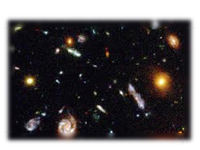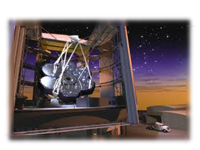 Today, it is well known that there are a huge number of galaxies in the Universe beyond our Milky Way Galaxy. Those extragalactic objects show various properties: various luminosities, various colors, various shapes, various components, and so on. To understand the formation and evolution mechanisms of those various galaxies has been one of the ultimate goals in modern astronomy. Particularly, for the last half century, great efforts have been made for it, both observationally and theoretically. That part of astronomy aiming to reveal the nature of the objects beyond the Milky Way Galaxy is called Extragalactic Astronomy.
Today, it is well known that there are a huge number of galaxies in the Universe beyond our Milky Way Galaxy. Those extragalactic objects show various properties: various luminosities, various colors, various shapes, various components, and so on. To understand the formation and evolution mechanisms of those various galaxies has been one of the ultimate goals in modern astronomy. Particularly, for the last half century, great efforts have been made for it, both observationally and theoretically. That part of astronomy aiming to reveal the nature of the objects beyond the Milky Way Galaxy is called Extragalactic Astronomy.
 Mostly, extragalactic objects look so faint and small that we need good telescopes and detectors to observe them with sufficient quality. Since telescopes with larger diameters enable us to investigate the objects in deeper Universe with higher details, astronomers have always wanted and tried to have larger telescopes. The size of the largest optical telescope currently operational is 10 m, but within several years, human beings will have much larger ones like the Giant Magellan Telescope (GMT) with 25 m diameter. In addition to the GMT, several great observational facilities will be available in the next decade, such as the Large Synoptic Survey Telescope (LSST), the James Webb Space Telescope (JWST) and the Square Kilometer Array (SKA).
Mostly, extragalactic objects look so faint and small that we need good telescopes and detectors to observe them with sufficient quality. Since telescopes with larger diameters enable us to investigate the objects in deeper Universe with higher details, astronomers have always wanted and tried to have larger telescopes. The size of the largest optical telescope currently operational is 10 m, but within several years, human beings will have much larger ones like the Giant Magellan Telescope (GMT) with 25 m diameter. In addition to the GMT, several great observational facilities will be available in the next decade, such as the Large Synoptic Survey Telescope (LSST), the James Webb Space Telescope (JWST) and the Square Kilometer Array (SKA).
The Galaxy Evolution Research Group in the Korea Astronomy and Space Science Institute (KASI) prepares the science for the upcoming era of those great facilities. We are working on various topics in extragalactic astronomy such as star clusters, dwarf galaxies, galaxy structures, galaxy environments, and supernovae.